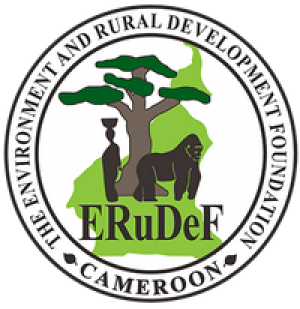[one_third] [/one_third]
[/one_third]
Community members of Woteva and Bakingili, all adjacent to Mt Cameroon have signed a Memorandum of Understanding (MoU) with the NGO, Environment and Rural Development Foundation (ERuDeF) committing themselves to plant seedlings of some threatened trees species in their community forests. The signing ceremony took place on June 20, 2014, between the Chief of Woteva, Woloko Bernard, the Forest Manager of Bankingili, Elive Thomas and ERudDeF’s Project Coordinator, Asa’a Lemawah. In bankingili, the ruler, Chief Elive signed on behalf of his community.
Through this MoU, these communities pledged to plant and nurture the trees planted. Already, the communities have begun planting over 5000 seedlings each of threatened species including Microberlinia bisulcata (Zingana), Entandrophragma angolenses (Mahogany), Prunus africana (Pygeum) and Afrostyllax lepidophyllus (Country Onion) in their community forests created some 14 years ago.
Prior to the signing of the MoU, ERuDeF staff held meetings to sensitize the communities and map out a strategy for the planting out of these threatened trees at the community forest. With the support of the communities, the ERuDeF team demarcated different areas to show where the different species would be planted.
The signing of this MoU, it would be recalled is within the framework of ERuDeF’s Tree Project Conservation of Threatened Trees at Mt Cameroon area. The Woteva and Bakingili Communities forests were selected as areas where the propagated threatened tree species raised within the project scope would be planted.
These community forests were created some 14 years ago within the framework of the new forestry policy of Cameroon Law which encourages the local communities to participate in the management of the forest estates through the creation of community forests. Given that the forests’ Simple Management Plan (SMP), highlights reforestation as a priority, vast areas of land formerly occupied by forests which have been turned into farmland were identified as a priority for regeneration. The taungya system was proposed as the most appropriate method for regeneration in the community forest especially the areas where farmlands had taken over. This implies, the trees are to be planted in these farms alongside food crops and would eventually take over the area after some years and the farm owners would simultaneously cater for the trees alongside their crops.
The community forests have suffered encroachment by adjacent forest communities since creation. To this regard, trees are being planted at the borders of the community forests especially where the boundaries cannot be easily determined. This would serve as clear boundary demarcations between the communities adjacent the forest, hence reducing boundary disputes.
By Asa’a Lemawah
